

Agile Design. 1.
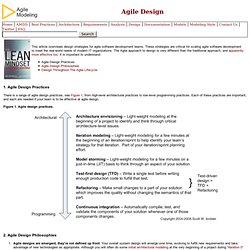
Agile Design Practices There is a range of agile design practices, see Figure 1, from high-level architectural practices to low-level programming practices. Each of these practices are important, and each are needed if your team is to be effective at agile design. Figure 1. Agile design practices. 2. 3. Figure 2. Figure 3. When a developer has a new requirement to implement they ask themselves if they understand what is being asked for.
If the team is taking a Test-Driven Development (TDD) approach the detailed design is effectively specified as developer tests, not as detailed models. Designing with agility — Mathew Sanders. 1.
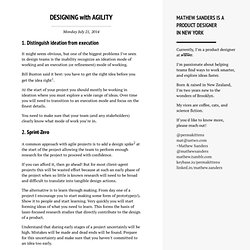
Distinguish ideation from execution It might seem obvious, but one of the biggest problems I’ve seen in design teams is the inability recognize an ideation mode of working and an execution (or refinement) mode of working. Bill Buxton said it best: you have to get the right idea before you get the idea right. At the start of your project you should mostly be working in ideation where you must explore a wide range of ideas. Over time you will need to transition to an execution mode and focus on the finest details. You need to make sure that your team (and any stakeholders) clearly know what mode of work you’re in. 2.
Black&White™ » Blog Archive » Getting to the Customer – Why Everything You Think about User-Centred Design is Wrong. Let me ask you a question.

If you had an idea for a new hammer and you wanted to test it, which of the following ways do you think would yield you the most valuable feedback? I am guessing most of you would choose #4. After all, getting a feel for the hammer requires the customer to actually try it out. Looking at a picture of a hammer, cutting it out, or even providing a Styrofoam prototype simply won’t provide you or the customer with sufficient foundation on which to evaluate it.
However, if I asked you to test a digital product, whether it be a website, an application or an e-commerce site, most of you would choose #1, 2 or 3. Isn’t that odd? A simple product like a hammer is best tested in its final form. Nonetheless, this is the current reality of applied UCD, or User-Centered Design. Usability tests, focus groups and personas to name a few, all are intended to increase usability, and create better products by having users test them.
Principles. Getting Real About Agile Design. Agile is here to stay.
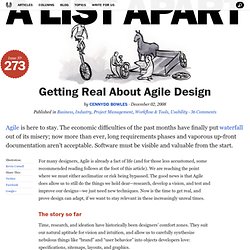
The economic difficulties of the past months have finally put waterfall out of its misery; now more than ever, long requirements phases and vaporous up-front documentation aren’t acceptable. Software must be visible and valuable from the start. For many designers, Agile is already a fact of life (and for those less accustomed, some recommended reading follows at the foot of this article). We are reaching the point where we must either acclimatize or risk being bypassed. The good news is that Agile does allow us to still do the things we hold dear—research, develop a vision, and test and improve our designs—we just need new techniques. The story so far#section1 Time, research, and ideation have historically been designers’ comfort zones. Agile, on the other hand, aims to deliver software quickly and handle change smoothly.
Research#section2 Given that Agile says “working software is the primary measure of progress,” there’s little room for detailed research. Understanding Agile Design and Why It’s Important. It’s no secret that the agile development process has been hurtling through the development world for several years now, swatting aside the older, clunkier waterfall development method.
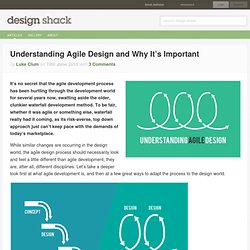
To be fair, whether it was agile or something else, waterfall really had it coming, as its risk-averse, top down approach just can’t keep pace with the demands of today’s marketplace. While similar changes are occurring in the design world, the agile design process should necessarily look and feel a little different than agile development; they are, after all, different disciplines. Let’s take a deeper look first at what agile development is, and then at a few great ways to adapt the process to the design world. A Quick Primer on Agile Development More than anything, the agile process emphasizes the production of on-time and on-budget deliverables, not perfection, as products can always be tweaked down the road.
Change on a Dime: Agile Design. What does it mean to have a good experience?

Think of your favorite restaurant, the interior of your car, and the software on your phone; how do people craft these experiences? Designing with Agile. Why Anders?
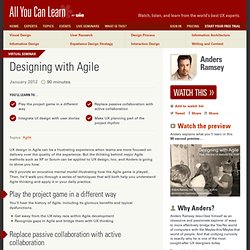
Anders Ramsay describes himself as an obsessive and passionate explorer of ways to more effectively bridge the Yes/No world of computers with the Maybe-this/Maybe-that world of people. And that undying curiosity is exactly why he is one of the most sought-after UX designers today. Beyond designing usable products for clients such as AOL, CBS, and Sony, Anders also is writing a book for Rosenfeld Media. The Agile Designer — Product Design. Knowing when to deviate from the norm is just as important as sticking to the norm.
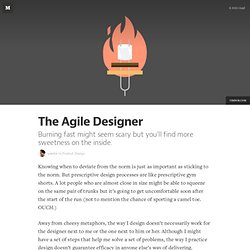
But prescriptive design processes are like prescriptive gym shorts. A lot people who are almost close in size might be able to squeeze on the same pair of trunks but it’s going to get uncomfortable soon after the start of the run (not to mention the chance of sporting a camel toe.